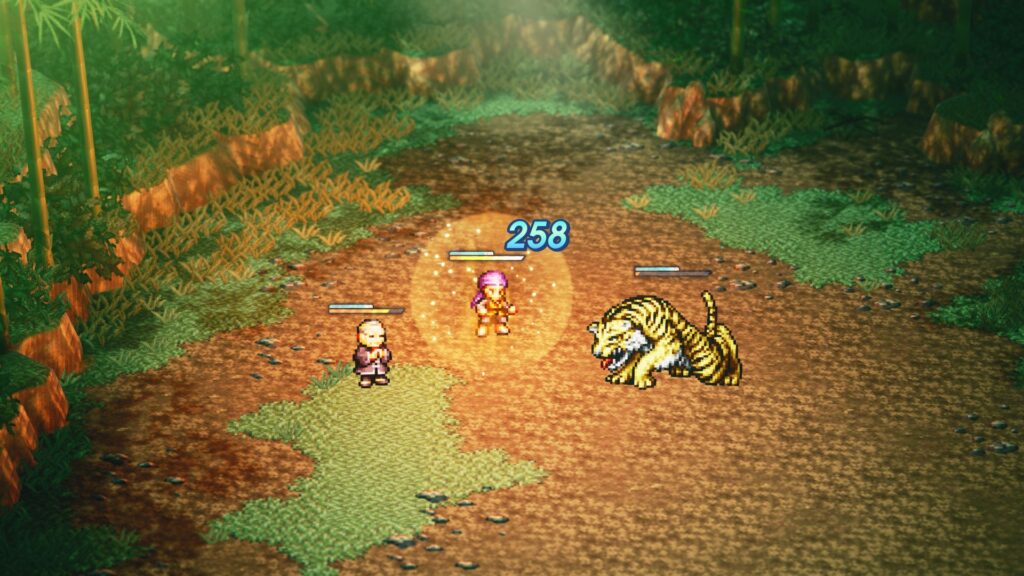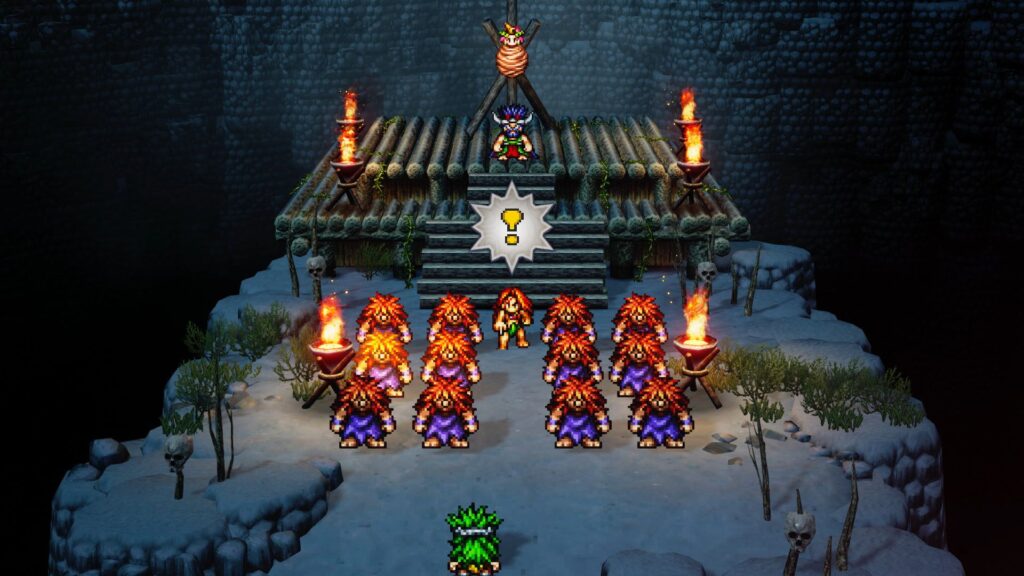Oh man, I was super hyped when Live a Live was announced in the Direct. An RPG that combined different periods with its unique gameplay elements and style drowned in a beautiful art style. The historian in me couldn’t be happier, and boy, did Live a Live live up to its name. Let’s dive in!
Alright, why is this game such a big deal? Well, mainly because it was never released outside Japan until now. It came to life as ‘Live A Live’ in 1994 as a role-playing video game developed and published by Square for Super Famicom. The game follows seven distinct scenarios across different periods, with two more unlockable scenarios linking the narratives through the recurring antagonist Odio. The gameplay is split between exploration with story-specific twists and turn-based combat on a grid.
History of Live a Live
Production began in late 1993 and was the directorial debut of Takashi Tokita. Tokita wanted to tell multiple stories within a single game, with each section drawing inspiration from different sources. Various manga artists handled character designs for the seven main scenarios. The music was composed by Yoko Shimomura as her first large-scale project after joining Square. Fast forward to 2022, and the remake for Nintendo Switch was released in July 2022, published by Square Enix in Japan and Nintendo worldwide. And you’re reading my review about it!
Gameplay
Let’s talk gameplay. As I mentioned in my introduction, Live A Live is a role-playing video game in which the player takes on the role of eight different protagonists through nine scenarios. While each narrative has the same basic mechanics, individual stories have unique gimmicks; these include using stealth, a lack of standard battles, or using telepathy to learn new facts to progress the narrative. (I’ll dive deeper into them in the next chapter). Except for one scenario, the player character navigates themed environments, ranging from the overworld area to dungeon environments. Battles are triggered differently for each scenario; some are random encounters, some have enemy sprites that can be avoided, and others are entirely scripted.
Battle System
The turn-based battle system is used across all scenarios and features the player character and sometimes a party fighting enemies on a 7×7 grid, with characters able to move and perform actions such as attacking or using particular skills. Skills can be used without limit, though some take multiple turns to charge. Some abilities imbue tiles with extra properties, such as healing a character or dealing elemental damage. There are also different skill systems in place; there are gaining levels with experience points, and unlocking new abilities, though character progression is locked behind story events in others. In one scenario, techniques are learned through seeing an opponent use them. Each character can also equip and use items, such as accessories, to boost attack or recover health. The game ends if the player character, or party, is defeated. I encourage you to at least die once; it shows a pretty awesome cutscene of how the world would ‘progress’ without you.
Remake
The 2022 remake carries over the basic gameplay from the original, though redesigned and updated for the new graphical style and with some features intended for ease of play compared to the original. For example, bars are added representing a character’s health and “charge” time before their move is executed. Other additions include a sparkling effect over items and materials that can be gathered, a display showing a move’s area of effect, and an optional radar system that offers the position of objectives on the map. So orange flags are your friend, ‘mkay?
Chapters
- Prehistory: The First: The caveman Pogo is exiled by his tribe after rescuing and hiding Bel, a woman intended for sacrifice by a rival tribe to their dinosaur god Odo. Pogo and Bel, helped by friendly members of both tribes, successfully kill Odo and establish peace between the tribes.
- Imperial China: The Successor: The aging Shifu of the endangered Earthen Heart martial art chooses three disciples to inherit his skills. A rival school led by Ou Di Wan Lee kills the two less experienced students. The Shifu and his surviving student defeat Ou Di Wan Lee and his students, then sacrifice himself to empower his surviving student. The Shifu dies after this battle, and his student begins passing down his teachings.
- Twilight of Edo Japan: The Infiltrator: Trainee ninja Oboromaru is sent by his master on a mission to rescue a politically influential person and kill his captor Ode Iou, a daimyo who has made a pact with demonic forces to conquer Japan. Oboromaru defeats Ode Iou and rescues the man, who turns out to be Sakamoto Ryōma, helping open Japan to the West.
- The Wild West: The Wanderer: A wandering gunslinger called the Sundown Kid meets with the bounty hunter Mad Dog in an isolated town for a gun duel. The pair end up working together to liberate the town from the Crazy Bunch bandit gang, led by O. Dio. After defeating O. Dio, revealed to be a horse possessed by the dead of the Battle of the Little Bighorn, the Sundown Kid leaves the town having rediscovered the value of protecting others, with his final encounters with Mad Dog varying depending on player choice.
- Present Day: The Strongest: Masaru Takahara wants to become the strongest person in the world, believing that defeating opponents in each fighting style would accomplish this goal. While Masaru succeeds, he is confronted by another fighter Odie O’Bright, who has been killing his opponents. Odie O’Bright challenges Masaru, who defeats him using his combined learned abilities.
- The Near Future: The Outsider: Psychic orphan Akira Tadokoro goes in pursuit of a biker gang called the Crusaders, seeking revenge for his father’s death. With his friend Matsu, Akira pursues the Crusaders, learning that the government is using them to obtain sacrifices for an idol called Odeo, which seeks to bring an enforced peace. Matsu−confessing that he killed Akira’s father as the Crusaders’ original leader−sacrifices himself trying to move the mech Steel Titan. With his powers, Akira uses the Steel Titan to destroy Odeo.
- The Distant Future: The Mechanical Heart: The cargo ship Cogito Ergo Sum is carrying a monster to Earth. Maintenance robot Cube investigates the incident when the monster escapes and begins killing the crew, which, combined with fatal accidents, causes the survivors to turn on one another. The ultimate culprit is the ship’s computer, OD-10, which wants to curtail the crew’s recurring antisocial behavior. Cube hacks and deactivates OD-10.
- The Middle Ages: The Lord of Dark: After the knight Oersted defeats his friend Streibough in a contest for the hand of Princess Alethea of Lucrece, Alethea is kidnapped by the Lord of Dark. Oersted leads a party that includes Streibough to rescue Alicia. They defeat the Lord of Dark, revealed to be a monster in disguise, but Streibough is killed, and Alethea remains missing. At the castle, Oersted is tricked by a magical illusion into killing Lucrece’s king, causing people to turn on him. Escaping, Oersted finds that a jealous Streibough faked his death. Oersted kills Streibough and finds Alethea, but she blames Oersted for Streibough’s actions before killing herself. A despairing Oersted becomes the new Lord of Dark, taking on the name Odio.
I loved these elements and enjoyed the ‘ancient’ chapters more than the nowadays chapters. They each felt like they fit the ‘era’ they represented. In addition, gameplay elements were catered around the tools present in the age the game was placed and made each chapter feel unique. Be wary, though; the chapters aren’t very long – you can quickly complete a chapter in around 2 hours of active gameplay (give or take). So don’t expect a very long game, but one that will sweep you off your feet.
And if it isn’t the gameplay that sweeps you off your feet, it will be the graphical style, which rocks the same manner as Octopath Traveler in a neat 2,5D style with stylish sprites in a pixelated world of gorgeousness. The same goes for the soundtrack, which can be listened to on repeat in the Jukebox mode (and I highly recommend you do so).
Conclusion
Overall, Live A Live is a splendid RPG and a nice throwback to the heyday of the genre in the 90s, all while rejuvenating the game in a way that makes it a standout title in 2022 for original and new fans alike. Each chapter tells a story with its cast, time, and location, yet all are done seamlessly and tie together nicely to form the overarching story. Then, to top it all off, the combat is fantastic, well designed, and precisely what you’d expect from a title that utilizes turn-based mechanics. I want more!







